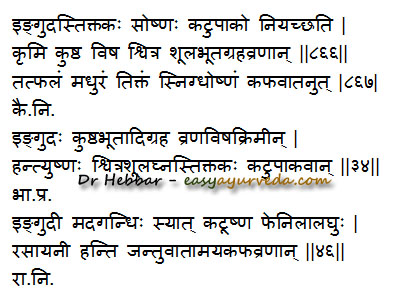Ingudi – Balanites aegyptiaca Uses, Research
Ingudi – Balanites aegyptiaca is used in treating intestinal worm infections, leucoderma and psychiatric disorders. Its fruit, Stem bark and Seed oil are used for medicinal purposes. Botanical Names- Balanites aegyptiaca (Linn) Del.
Family- Balanitaceae (Simarubaceae), Zygophyllaceae (Ingudi kula)
Taxonomical profile
Kingdom : Plantae
Division : Magnoliophyta
Class : Magnoliopsida
Order : Sapindales
Family : Zygophyllaceae
Genus : Balanites Delile
Species : Balanites aegyptiaca (L.) Delile
Table of Contents
Vernacular names
Names in different languages:
English name – desert date, soapberry tree or bush, Thorn tree, Egyptian myrobalan, Egyptian
Hindi name- Hingoon, Ingot, Hingua
Tamil name- Nanjanada
Telugu name- Gara chettu, Ringari
Marathi name – Hingan
Bengali Name – Hing
Arabic name – lalob, hidjihi, inteishit, and heglig
Unani : Hingan, Hanguul
Siddha : Nanjunda
English : Desert date, Soapberry tree, Thorn tree,, Egyptian balsam
Arabic : Heglig
French : Dattier du desert, Hagueleg, Balanite
Spanish : corona di Jesus
Sanskrit Synonyms
Tapasadruma, Bhallaka, Binduka, Vyavaharika Hingupatra, Vishakanta, Kroshtuphala
Anilantaka, Shoolari – Balances Vata Dosha
Pootikarnina, Pootigandha, Madagandhi, Vigandhaka – Having bad odor
Angara Vruksa – wood is used as fuel
Classical categorization
Kaiyadeva Nighantu – Oshadhi Varga
Raja Nighantu – Shalmalyadi Varga
Bhava Prakasha – Vatadi Varga
Chemical composition
Balanites aegyptiaca chemical composition:
Fruit- Balanitisines A,B,C,D & E
Seed Kernal- Balanitiesin
Leaves- Nitogenin, Diosgenin
The seed contains 30-48% fixed (non-volatile) oil, like the leaves, fruit pulp, bark and roots, and contains the sapogenins diosgenin and yamogenin
Roots, bark wood and fruit contain saponins.
Morphology
Small spiny tree with grayish bark
Leaves- bifoliate, elliptic or obovate
Flowers – Greenish white in color
Fruits – Drupe, green when tender and turns to yellow on ripening
Medicinal properties
Balanites aegyptiaca medicinal Properties:
Rasa (taste) – Tikta – bitter, Katu – Pungent
Guna (qualities) – Laghu – light to digest, Snigdha – unctuous, oily
Vipaka- Katu – Undergoes pungent taste conversion after digestion
Veerya (potency) – Ushna – Hot
Prabhava – Krumighna
Effect on Tridosha – Balances Kapha and Vata
Part used, dosage
Part used– Stem bark, fruit, Seed oil
Dosage–
Decoction 50-100 ml,
Powder 3-6 g
Fruit pulp 3-6 g
Seed oil – 5-10 drops
Sanskrit verse

Uses, indications
Balanites aegyptiaca uses:
Rasayana – anti aging, causes cell and tissue rejuvenation
Indicated in –
Krumi – worm infestation
Kushta – skin diseases
Visha – Toxic conditions, poisoning
Shvitra – leucoderma, vitiligo
Shoola – abdominal colic pain
Bhootagraha – Psychiatric disorders
Oil extracted from it – Ingudi Taila is used for treating intestinal worms, as hair oil and for wound healing.
Seed, bark, leaf and fruit – all are useful against parasitic infection
As per Sushruta Sutrasthana 45, Its oil is Shukrapaha – anaphrodisiac and not good for eyes.
Its fruit is mixed into porridge and used in lactating mothers to improve breast milk production. It also relieves headaches.
As per Bhojana Kutuhala the ingudi oil is sweet in taste, cold in nature, removes excess of pitta, improves complexion, promotes strength and hair growth and also aggravates kapha dosha.
Interaction with medicines, supplements
Can this be used while taking Homeopathic medicine?
Yes. This product does not react with homeopathic medicine.
Can this medicine be continued while taking supplements like multivitamin tablets, Omega 3 fatty acids etc?
Yes. Generally, this product goes well with most dietary supplements. However, if you are taking more than one product per day, please consult your doctor for an opinion.
With western
medicines
Seek your
doctor’s advice if you are taking this product along with other western
(allopathic / modern) medicines. Some Ayurvedic herbs can interact with modern
medicine.
If both Ayurvedic and allopathic medicines are advised together, then it is
best to take Allopathic medicine first, wait for 30 minutes and then take the
Ayurvedic medicine.
Formulations
Ingudi taila – indicated in Kusha
Manashiladi dhuma
Loha rasayana
Ingudi lepa
Pharmacological action – Purgative, Anthelmintic, Spasmolytic, Anti microbial
Research
Systemic Action (Sthanika Karma)
External – Oil has Anti microbial, Wound healing action. Promote hair growth. Indicated in burns, boils, wounds etc. Bark is highly potent, and can be used for nasya in diseases affecting head and neck.
Digestive System – Carminative, induce purgation, Anthelmintic. indicated in low digestive strength, abdominal colic, Helminthiasis, constipation etc. .
Its Seed, Bark, Leaves, and Fruits possesses potent Antimicrobial property.
Circulatory System – Rakta sodhaka
Respiratory system – Fruit pulp is indicated in chronic cough, breathing disorders etc. Helps to expel kapha dosha.
Excretory System – Flower is indicated in Dysuria
Reproductive system – Decreases sperm production
Tvak – Indicated in Leucoderma, and in other skin diseases
Satmikarana – Ant Poisonous










